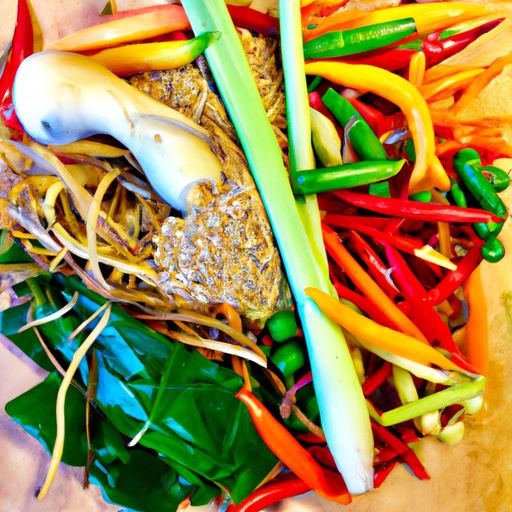Have you ever wondered how Thai curries are made? Join us on a flavor-filled journey as we explore the art of Thai curry making. From the vibrant red curry bursting with chili heat and lemongrass fragrances, to the fresh and herbaceous green curry, and the mellow yet uplifting yellow curry, we’ll delve into the secrets behind these mouthwatering delights. Prepare to be captivated by the rich and diverse world of Thai cuisine, where every dish tells a story and every bite takes you on a sensory adventure. Get ready to discover the art of Thai curry making with Tastepan.com, where food is not just nourishment but a celebration of culture and tradition.
The Art of Thai Curry Making: Red, Green, and Yellow Delights
Thai cuisine is renowned for its vibrant and flavorful curries. Among the various types of Thai curries, the most popular ones are the red, green, and yellow curries. Each curry has its own distinct characteristics, ingredients, and flavors, making them a delight for every curry lover.

Ingredients
Red Curry
The red curry is made using red chili peppers, which give it its distinct fiery red color. Other key ingredients include garlic, shallots, galangal, lemongrass, shrimp paste, and a variety of aromatic spices. Coconut milk is added to balance the spiciness and provide a rich and creamy texture.
Green Curry
The green curry gets its name from the vibrant green color, which comes from green chili peppers. It is made with a combination of ingredients, including green chilies, Thai basil, coriander, kaffir lime leaves, lemongrass, garlic, and shallots. Coconut milk is also added to give it a creamy consistency.
Yellow Curry
The yellow curry stands out with its golden yellow color, which comes from turmeric. It is typically milder in flavor compared to red and green curries. The main ingredients include turmeric, cumin, coriander, lemongrass, garlic, shallots, and coconut milk. Yellow curry is often referred to as the mildest and most soothing curry among the three.
Preparation
Red Curry
To prepare red curry, start by pounding together the red chili peppers, garlic, shallots, galangal, and lemongrass to form a paste. Then, sauté the paste in a pan until fragrant. Add the desired protein (such as meat, seafood, or tofu) and vegetables, followed by coconut milk. Simmer until the protein is cooked through and the flavors meld together.
Green Curry
To make green curry, pound together the green chili peppers, Thai basil, coriander, kaffir lime leaves, lemongrass, garlic, and shallots to form a paste. In a pan, sauté the paste until aromatic. Add the protein and vegetables, followed by coconut milk. Allow the curry to simmer until the flavors are well incorporated.
Yellow Curry
For yellow curry, start by blending together turmeric, cumin, coriander, lemongrass, garlic, shallots, and other desired spices to form a paste. In a pan, sauté the paste until fragrant. Then, add the protein, vegetables, and coconut milk, and let the curry simmer until the flavors blend together perfectly.

Cooking Techniques
Red Curry
The cooking technique for red curry involves sautéing the curry paste to release its flavors and aromas. This step is crucial as it helps to enhance the overall taste of the curry. Simmering the curry allows the ingredients to cook slowly and infuse the dish with an array of delicious flavors.
Green Curry
Similar to red curry, green curry starts with sautéing the curry paste. This helps to bring out the flavors and aromas of the ingredients. Simmering the curry allows the flavors to meld together and create a well-balanced and aromatic dish.
Yellow Curry
Yellow curry also begins with sautéing the curry paste to unlock the flavors of the spices. Simmering the curry helps to infuse the dish with the combination of spices and create a harmonious blend of flavors.
Serving Suggestions
Red Curry
Red curry is typically served with steamed jasmine rice, which helps to balance the spiciness of the curry. It can also be enjoyed with fresh herbs, such as Thai basil, cilantro, or mint, which add a refreshing touch to the dish. Additionally, red curry pairs well with crispy fried shallots and lime wedges for an extra burst of flavor.
Green Curry
Green curry is traditionally served with steamed jasmine rice, which complements the flavors of the curry. It is often garnished with fresh Thai basil leaves or sliced kaffir lime leaves for added freshness and fragrance. A squeeze of lime juice before serving enhances the overall taste of the dish.
Yellow Curry
Yellow curry is commonly enjoyed with steamed rice or Thai roti, a type of flaky bread. The mild and soothing flavors of yellow curry make it a great choice for those who prefer milder curries. Garnishing with fresh cilantro and a sprinkle of crispy fried onions adds a delightful texture and flavor to the dish.

Variations
Red Curry
There are several variations of red curry that include different ingredients and flavors. For example, red curry can be made with duck, pork, or even pineapple for a unique twist. By adjusting the level of spiciness or adding additional ingredients, such as Thai eggplants or bamboo shoots, you can create your own signature red curry.
Green Curry
Green curry also offers various possibilities for customization. It can be prepared with different proteins, such as chicken, beef, or tofu, and a wide range of vegetables, including bell peppers, green beans, and zucchini. Adding Thai eggplants or pea eggplants can elevate the flavors and add a new dimension to the dish.
Yellow Curry
Similarly, yellow curry can be customized according to personal preferences. You can experiment with different proteins like shrimp, fish, or vegetables like potatoes, carrots, and cauliflower. By adding unique ingredients like tamarind paste or fish sauce, you can create a distinct and flavorful yellow curry.
History and Origins
Red Curry
The exact origins of red curry are not well-documented, but it is believed to have originated in Central Thailand. The use of red chili peppers as a key ingredient in Thai cuisine can be traced back to the Ayutthaya Kingdom. Red curry has since become a staple in Thai cuisine and is enjoyed in various regions across the country.
Green Curry
Green curry, also known as “gaeng kiaw wan” in Thai, has its roots in Central Thailand. It was traditionally made with wild boar, which was abundant in the region. As the dish gained popularity, it evolved to include a variety of proteins and vegetables, making it a versatile and beloved Thai curry.
Yellow Curry
Yellow curry, or “gaeng leung” in Thai, is thought to have originated in Southern Thailand. The use of turmeric as a key ingredient reflects the influence of Indian and Malay culinary traditions in the region. Over time, yellow curry has become a staple across Thailand, loved for its milder and comforting flavors.
Famous Thai Curry Dishes
Thai cuisine boasts some famous curry dishes that have gained recognition worldwide for their tantalizing flavors and unique combinations of ingredients.
One such dish is Massaman curry, which is a flavorful combination of spices and flavors influenced by Persian and Indian cuisines. It is made using a variety of ingredients, including coconut milk, tamarind paste, peanuts, potatoes, and meat or tofu. Massaman curry is known for its rich and complex flavors, making it a favorite among curry enthusiasts.
Another renowned Thai curry dish is Panang curry, which originated in Central Thailand. It is made with a thick and rich curry paste containing ingredients like dried chili peppers, coriander seeds, and cumin. The flavors of Panang curry are often enhanced with coconut milk, kaffir lime leaves, and a hint of sweetness from palm sugar. It is commonly enjoyed with jasmine rice and is well-loved for its creamy and aromatic taste.
Best Thai Curry Restaurants
When it comes to experiencing the authentic flavors of Thai curry, there are several renowned restaurants that are known for serving exceptional curries.
One such restaurant is “Bo.lan” in Bangkok, helmed by Chef Duangporn Songvisava and Chef Dylan Jones. Bo.lan is famous for their commitment to using sustainable and locally sourced ingredients, resulting in curries that are not only delicious but also environmentally friendly.
Another notable Thai curry destination is “Somboon Seafood” in Bangkok. This renowned restaurant is known for its legendary crab curry, which is a must-try for seafood lovers. The curry is made using a secret family recipe that has been passed down for generations, ensuring a truly unforgettable dining experience.
Health Benefits
Red Curry
Red curry offers several health benefits due to its use of ingredients such as red chili peppers, garlic, and spices. Red chili peppers contain capsaicin, which has been shown to boost metabolism and aid in weight loss. Garlic is known for its antibacterial and antiviral properties, while the spices used in red curry, such as turmeric, cumin, and coriander, have anti-inflammatory effects.
Green Curry
Green curry is packed with nutrients from ingredients like green chili peppers, Thai basil, and coriander. Green chili peppers are a rich source of vitamin C and antioxidants, which can support the immune system and fight against free radicals. Thai basil and coriander have antioxidant properties, and they also provide essential vitamins and minerals.
Yellow Curry
Yellow curry offers a range of health benefits, largely due to the inclusion of turmeric. Turmeric contains a compound called curcumin, which has powerful anti-inflammatory and antioxidant properties. Consumption of curcumin has been linked to various health benefits, including reduced inflammation, improved cognitive function, and lower risk of chronic diseases.
Conclusion
Thai curries, including red, green, and yellow curries, are a true culinary delight that brings together a blend of flavors, colors, and aromas. Whether you prefer the fiery spiciness of red curry, the aromatic freshness of green curry, or the mild and comforting flavors of yellow curry, there is a Thai curry to suit every palate. The art of Thai curry making is a testament to the country’s rich culinary heritage and the creativity of its chefs. So, next time you crave a taste of Thailand, venture into the world of Thai curries and dive into a truly delightful experience.

